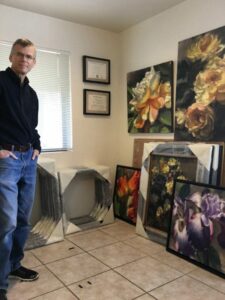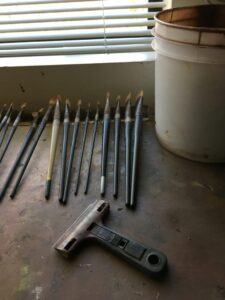
Because of this there is a lot of walking back and forth from the viewing point and the canvas. And it was also for this reason that I was also taught to use a wooden thumb palette – so it is always at hand for mixing paints.

This is what I now use to mix my colors. I still walk back and forth from my viewing point to the canvas, but the palette table sits directly in front of the canvas so that is where I do all of my paint mixing. I feel it has transformed my work since it has liberated me to mix copious amounts of paint with large bristle filbert brushes. I use bristle filberts of all sizes, but for the initial lay in I like to use number 12 filberts (about ¾ inch wide), and larger. I have several that are number 24 (about 2 inches wide).
So my oversize palette is a favorite thing. But to make using a large glass palette practical, I have to mention another favorite tool. I used to use a small razor blade window scraper to clean my palette. It was a habit I picked up from other artists, and it seemed more efficient and effective than using a palette knife. But one day when I was at the hardware store I discovered an extra-large window scraper with a four inch blade, and I now find it indispensable for quickly scraping and cleaning the large expanse of glass.


Kurt Anderson says
I was painting a more traditional still life when I wrote this blog, but there is another side of my artistic personality. My “contemporary” florals are often of single blooms painted oversize, very loosely, and with copious amounts of paint. These demonstrate how the palette has allowed me to explore and expand my repertoire.